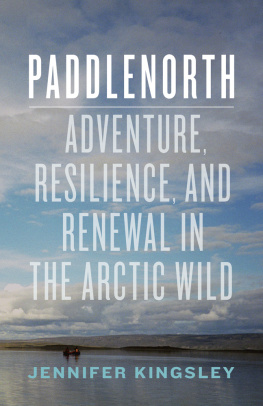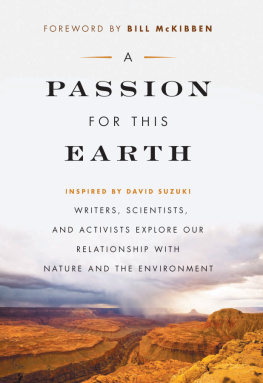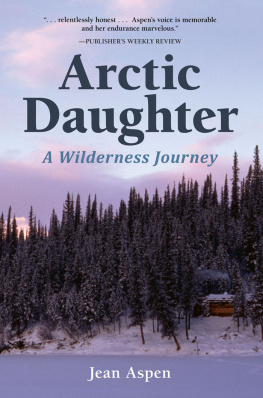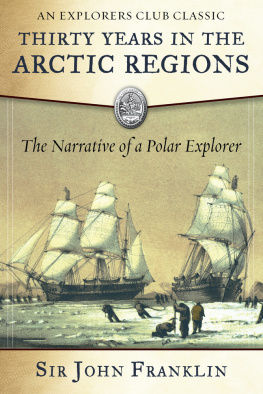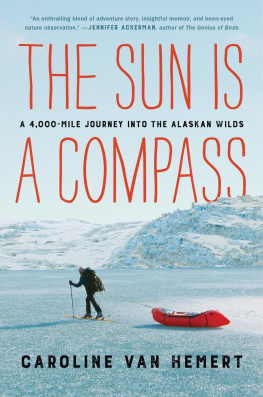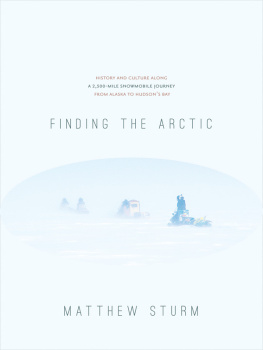ONE
TO BEGIN, TO BEGIN
I CLIMBED THE thin steps of the Twin Otter floatplane carefully; it wouldnt do to twist an ankle before take-off. I squeezed by our stack of canoes and slid into a cold metal seat. As we taxied out into the bay and accelerated, the planes vibrations became a steady roar. I reached for the company-issued earmuffs and prepared to be pushed back in my chair as we nosed upward. The plane dragged the heels of its pontoons along the water, and suddenly we were airborne.
I was surrounded by camping gear, fifty days worth of food, and my five companions. Yellowknife disappeared within moments, along with the silver edge of Great Slave Lake. Ponds and small lakes stared blackly upward, and golden muskeg glowed between spruce trees. The horizon arced in the distance, and I wanted to believe that wilderness would not be broken again as we headed north. I stared at the ground, looking for animals, and my eyes were rewarded, not with moose or caribou, but with a paved road that gave way to gravel, and finally to the open pit of a diamond mine. The land was big enough to swallow hundreds of thousands of caribou, powerful rivers, and fresh scars of industry. I was used to studying the landscape from the black and white lines of topographical maps most of which are too old to show the territories newer faces.
Despite my nervousness and excitement, the howl of the airplane, and the cold that crept through its metal shell, I slumped against the wall and slept. Preparing for the trip had exhausted all of us. While I napped, we continued north, and the trees thinned out into isolated clumps and then disappeared altogether. I awoke to find Drew with his forehead pressed to the window, his eyes open wide in amazement. We had reached the tundra in springtime; no trees, but lots of ice. We were only the third group of paddlers to be dropped off by the air charter company so far that summer. All of the lakes, about half the surface of the land, flared white under the clouds. The ground resembled a muted painters palette of grays, browns, and yellows mixed between bright patches of snow. No recognizable landforms stood out, no movement. Pools of color stretched to the curve of the earth.
Our planned landing was impossible; only a few sections of river were unfrozen. Tim wrestled with the map and pointed. The pilot nodded; the plane dipped left and spiraled down, its nose seeking water below. My view alternated from land to sky, land to sky, unsettling the lunch in my belly. The wings finally stabilized, but ice still zoomed under our feet. I felt the river before I saw it. We stuttered across its surface.
The Baillie River wears a trough into the tundras rocky plain. This tributary would lead our group of six to the Back River, a massive 1,000-kilometer-long waterway that drains the central mainland of Nunavut, Canadas largest and northernmost territory. The Back boasts over eighty sets of rapids, 10-foot standing waves, boiling chutes, and an enormous system of lakes. We planned to spend fifty days winding our way to the Arctic Ocean. And it would all start here. My feet froze in the water as I carried a pack to shore. The river was only about 25 meters across.
The plane buzzed overhead and dipped its wings in farewell. I stood at the waters edge in a thin yellow windbreaker I wouldnt wear again for the rest of the trip, and scanned our heap of gear: three boats, three personal packs, four food packs, four food barrels (hip height, waterproof, and made from blue plastic), two wannigans (voyageur-style wooden boxes with removable lids and tumplines for carrying), and a mess of paddles, PFDs (personal flotation devices, aka life jackets), helmets, and day packs. Gusts of wind pulled at my hair and found the gap above my waistband. The painters palette had sprung into a relief of small rises, but without trees or familiar landmarks, scale was hard to figure out.
We stood around feeling stunned by our new reality we had been eating take-out noodles in Yellowknife three hours earlier until Levi checked his thermometer and broke the silence. Its only one degree, he said. And how about that windchill?
We scattered after that.
Alie sat down; Drew and Jen walked away from the water, picking up stones; Levi looked up at the sky; Tim walked the farthest. I stood by the river and cast my mind back three years to the first time I had set foot on the tundra. Is this what I remember? That summer lived in my memory as a sunny, buggy adventure filled with laughter and the good kind of challenge. It occurred to me that it might not be the same this time.

Arrival on the Baillie River. Left to right: Levi Waldron, Tim Irvin, Jenny Kingsley, Drew Gulyas, Jen McKay, Alie Pick. CREDIT: TIM IRVIN
We came back together eventually, and Tim showed me the handful of soft brown qiviut, the underfur from a muskox, that he had found on the ground. He tucked it into a pocket and set up the camera for a picture. The six of us stood close together with our arms entwined. We smiled with pale faces, short hair, new pants, and clean shoes. We stared straight at the lens, our feet planted squarely on the tundra except my right foot and Alies left, which rolled out as if the ground were too hot or cold to stand on. Levi had a dark bandana wrapped around his black hair, and his Leatherman Multi-Tool hung from his belt. Tim draped an arm around Levis shoulder and smiled broadly from under a baseball cap. Drew and I stood in the middle, freshly washed and confident, no hats. My dark hair barely curled behind my ears; his orange mop was cropped to a frizzy brush cut. Sunglasses held back Jens blonde hair like she was having a day at the beach and she wrapped her arm around Alie, whose red fleece looked fresh off the rack.
The tundra filled in all around us. We stood on coarse, beige sand littered with fist- and skull-sized rocks. Each one was a different color gray, black, purple, pink and each was tattooed with splotches of lichen. Green and brown vegetation darkened the background, next to a small lake, and the horizon line cut behind us at waist level. Above it all, the clouds seemed to spread from a single point. They papered the sky white.

THAT FIRST AFTERNOON was a blur of moving bags and searching for gear. We decided not to travel, or cook, until the next morning; the noodles would suffice until we slept.
Tim and I shared a tent the first night, but he didnt say much. I think he saved his energy for the group during those early days. He lay down with his back to me and started sleep-breathing within minutes. I had always envied his ability to fall asleep anywhere, anytime.
I slid off my outer clothes and climbed into the pouf of my sleeping bag. It smelled moist. My clammy feet stuck to the nylon. I lay back and waited for my body heat to generate a warm shell. I had no idea what time it was. Our tents crouched on the sand, 2 degrees south of the Arctic Circle, four days after the summer solstice. The sun would dip below the horizon for about three hours.
Silence filled the evening. The wind wasnt strong enough to make noise or push the tents around. I strained to hear something outside, but I couldnt. Not even the whine of a mosquito; it was still too cold for them. Tims breathing, the odd rustle of nylon from the vestibule, every movement of my sleeping bag, and the sound of my legs shifting against my Therm-a-Rest completed the soundtrack.
I pulled out my journal and flipped through it in the beige light of the tent.
The first sixty-one pages were already covered with calculations and lists dating back six months to January 2005. Everything from food weights to diagrams of eddy turns to expenses and endless food shopping lists. Some items were cryptic:

